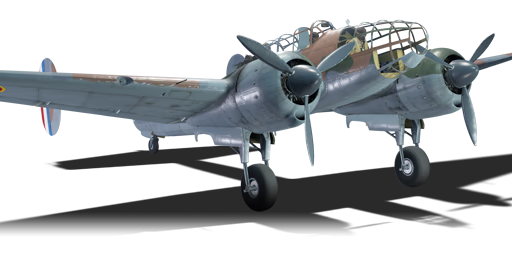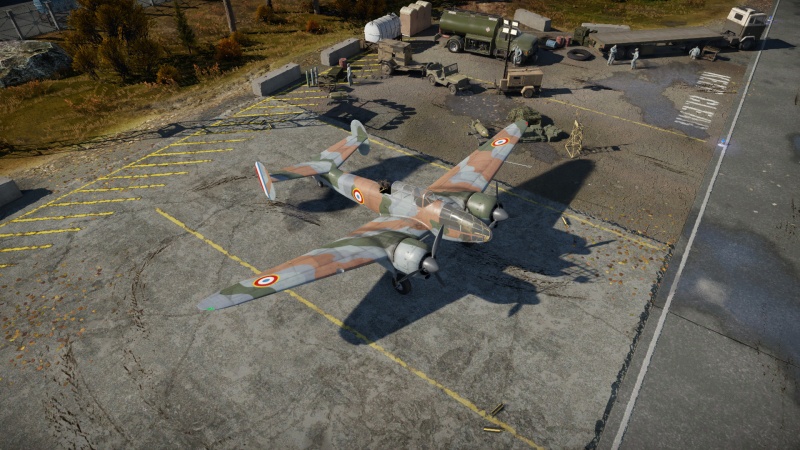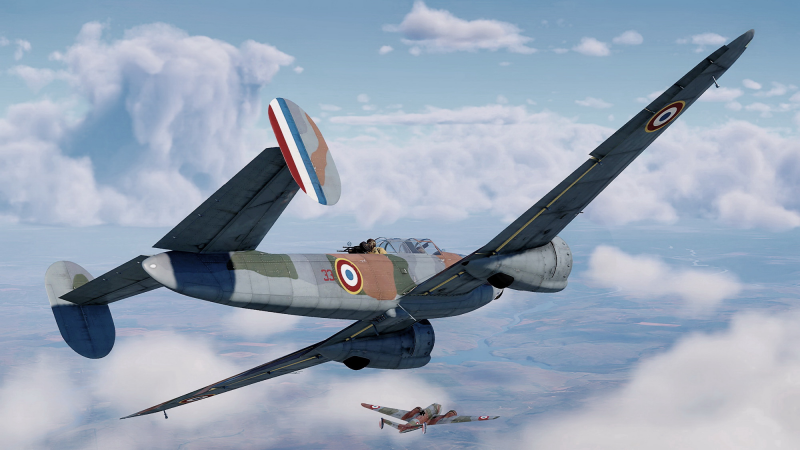M.B.174A-3
Contents
Description
The M.B.174A-3 is a rank I French bomber with a battle rating of 2.0 (AB) and 2.7 (RB/SB). It was introduced in Update 1.73 "Vive la France".
The M.B.174 is a fast bomber made for ground attack. Like a twin-engine strike aircraft, it is able to drop bombs with high accuracy in a ground attack role and use its speed to get away from any return fire.
General info
Flight performance
The M.B.174A-3 is rather manoeuvrable flying in a straight line since the aircraft can roll pretty well and has acceptable elevator motion. When in a combat situation, this changes considerably as the plane is difficult to handle in dives and turns. Trying to approach a bombing target in a diving turn, the M.B.174 is very slow to turn around and the bow keeps pointing way off the line of flight. Even using full rudder control, the bow of the plane just does not follow the turn, making it likely that the bombs will miss their target. In addition, the M.B.174 does not conserve energy well and trying to climb will reduce speed to under 200 km/h, in which case the pilot can expect to be an easy score for any enemy.
But like all aircraft at this BR, the best solution for air combat is not getting caught in the first place. The M.B.174 however can run away better than its peers because it is blazing fast; it easily outruns all but the fastest fighters and any strike aircraft trying to intercept you bites the dust in a chase. The speed is definitely something which the M.B.174 has over other single-engined strike aircraft, as it has two 1,073 HP engines which easily outpower anything at the BR it is in.
| Characteristics | Max Speed (km/h at 3,780 m) |
Max altitude (metres) |
Turn time (seconds) |
Rate of climb (metres/second) |
Take-off run (metres) | |||
|---|---|---|---|---|---|---|---|---|
| AB | RB | AB | RB | AB | RB | |||
| Stock | 511 | 497 | 10300 | 19.9 | 20.6 | 8.2 | 8.2 | 450 |
| Upgraded | 566 | 537 | 18.7 | 19.0 | 16.4 | 11.6 | ||
Details
| Features | ||||
|---|---|---|---|---|
| Combat flaps | Take-off flaps | Landing flaps | Air brakes | Arrestor gear |
| ✓ | ✓ | ✓ | X | X |
| Limits | ||||||
|---|---|---|---|---|---|---|
| Wings (km/h) | Gear (km/h) | Flaps (km/h) | Max Static G | |||
| Combat | Take-off | Landing | + | - | ||
| 680 | 280 | 330 | 317 | 260 | ~12 | ~5 |
| Optimal velocities (km/h) | |||
|---|---|---|---|
| Ailerons | Rudder | Elevators | Radiator |
| < 325 | < 200 | < 480 | > 180 |
Survivability and armour
- 8 mm Steel plate behind the pilot's head.
Modifications and economy
The stock configuration gives you largely ineffective 50 kg bombs, so researching the 500 kg bomb is imperative to the plane's success.
Armaments
Offensive armament
The M.B.174A-3 is armed with:
- 2 x 7.5 mm MAC 1934 machine guns, wing-mounted (500 rpg = 1,000 total)
The two machine guns are arranged with one mounted in each wing. Each is armed with the same amount of ammunition, which means that all guns will fire with each other until empty. The problem with using your frontal armament is that you will have a hard time lining up on your target considering the sluggish turn time and the rapid energy bleeding which comes with moving your plane in ways it was never designed for: hitting anything with your two rifle-calibre MGs is also hard because the guns are mounted on the wings, very far away from the centre of the aircraft, making gun convergence a huge factor in aiming.
Suspended armament
The M.B.174A-3 can be outfitted with the following ordnance:
- 8 x 50 kg G.A. MMN. 50 bombs (400 kg total)
- 1 x 500 kg No.2 bomb (500 kg total)
Defensive armament
The M.B.174A-3 is defended by:
- 2 x 7.5 mm MAC 1934 machine guns, dorsal turret (400 rpg = 800 total)
- 3 x 7.5 mm MAC 1934 machine guns, ventral turret (500 rpg = 1,500 total)
The defensive armament of two MGs on the back of the cockpit does not amount to much, although if you can move your plane into directly lining up with the enemy on your six you can unleash the three bottom-mounted MGs too which might suffice in taking down the pursuer.
Usage in battles
With its heaviest and most effective bombload being a single 500 kg bomb held by bomb locks, the M.B.174 can effectively dive bomb. The recommended strategy is basically to dive on targets to secure a kill with a low number of high-weight bombs; a playstyle similar to the Ju 87 B-2 or the TBF-1C. The only limitation to this strategy is that you cannot drop bombs while making a diving turn due to your twin-engine configuration. However, considering those engines provide you with a near-unmatched speed this is a worthwhile tradeoff.
Tactics should be focused on bombing ground targets with a straight line approach and a clear exit away from the enemy. The 50 kg bombs are not effective against any ground target. In attack mode, the 7.5 mm MG don't make much of a dent on enemies, and since ammo runs out quickly, any attack must be carefully planned. Attacking bombers at higher altitude is not advisable. Fighters busy in turn fights can be attacked if you have an altitude advantage and a line of exit. After bombing the target, by turning away from the enemy and descending at the same time you will probably be able either to outrun or keep up with most of the enemy fighters at this BR.
In conclusion; the M.B.174 is a twin-engine strike aircraft disguised as a bomber, with a superb speed and reasonable manoeuvrability. It however lacks sufficient defensive armament and the frontal armament is only effective against unaware open-topped vehicles. The bomb load is comparable to other strike aircraft of the BR, though the stock loadout is largely ineffective. All things considered it is definitely a good plane to have in your ground RB lineup, considering it can drop the 500 kg bomb pretty precisely and evade any AA or pursuers after securing a kill. In air battles, the plane is largely overshadowed in the bomber role by the N.C.223.3 and in the twin-engine strike role by the Potez 631.
Manual Engine Control
| MEC elements | ||||||
|---|---|---|---|---|---|---|
| Mixer | Pitch | Radiator | Supercharger | Turbocharger | ||
| Oil | Water | Type | ||||
| Controllable | Controllable Not auto controlled |
Not controllable Not auto controlled |
Controllable Not auto controlled |
Combined | Not controllable 1 gear |
Not controllable |
Pros and cons
Pros:
- Superb speed for a bomber
- Extremely manoeuvrable for a bomber
- Has offensive armament which despite its weakness makes it relatively unique to other bombers
- Can drop a very forgiving bomb with high precision in a ground attack role
Cons:
- Extremely weak stock payload
- Poor defensive armament
- Has little purpose in air battles
History
Evolution of the MB.170, this new model definitively abandoned the belly turret and the crew's typical layout was revised. The cockpit and front-end glazing were again modified, however, the MB.170-02's tail was retained. Intended specifically for reconnaissance with a secondary bombing mission, the prototype took the air on 5 January 1939 in Villacoublay piloted by René Le Bail with 14M-20/21 Gnome & Rhône engines of 1,030 hp. Six pre-production aircraft were ordered to activate the development of the twin-engine aircraft, but this aircraft proved to be very fast and easy to fly from the first tests, manoeuvrable even at very high altitude and an order for 50 serial copies was notified on 1 February 1939. Intended to replace the Potez 63.11 of the war, they were to receive 14M-48/49 Gnome & Rhône engines of 1,100 hp, but the first tests carried out with the pre-series aircraft revealed cooling problems. It was, therefore, necessary to reduce the diameter of the propeller pans in order to increase the airflow on the cylinder heads. Finally, just before the commissioning it was decided to increase the armament, which was finally attached to two 7.5 mm MAC 1934 machine guns in the wings and three mounted in removable ventral fairings pulling forward, a dorsal machine gun and a ventral weapon of the same type pulling backwards. The belly compartment allowed 400 kg of bombs to be carried, but in its initial version, its capacity was in fact limited to 8 x 40 kg bombs which was clearly insufficient in most operations. The production was launched in November 1939 at the SNCASO plant in Bordeaux-Mérignac, but because of the modifications made to the planes during their development the first 20 MB.174 were accepted by the air force only in February 1940 and put into service in March 1940 to the strategic reconnaissance group GR II/33. 56 copies were delivered until June 22, 1940. In operations, this twin-engine aircraft was able to outrun the best German fighters then in service and only 4 MB.174 were lost to the enemy during the Battle of France.
During Battle of France on May 1940, the famous French writer Antoine de Saint-Exupery flew a Bloch M. B 174 with the Groupe de reconnaissance II/33 in a squadron of Armée de l'Air. On 23rd May of 1940, he made a recon mission above the city of Arras during the German invasion and his plane was heavily damaged by Flak and attacked by fighters however he managed to get back at his airfield and save his crew. Due to this heroic action, he was awarded of Croix de Guerre (Iron Cross) on 2nd June 1940. This mission inspired him a book named Pilote de Guerre. (Flight to Arras)
Media
- Skins
See also
Links to the articles on the War Thunder Wiki that you think will be useful for the reader, for example:
- reference to the series of the aircraft;
- links to approximate analogues of other nations and research trees.
External links
| Dassault Aviation | |
|---|---|
| WW2* | |
| Fighters | M.B.152C1 · M.B.157 |
| Bombers | M.B.162 · M.B.174A-3 · M.B.175T |
| Jet Aircraft | |
| M.D 450 | M.D.450B Barougan · M.D.450B Ouragan |
| Mystère | M.D.452 IIA · M.D.452 IIC · Mystere IVA |
| Super Mystère | Super Mystere B2 |
| Étendard | Etendard IVM |
| Super Étendard | Super Etendard |
| Alpha Jet | Alpha Jet E** |
| Mirage | |
| Mirage III | Mirage IIIC · Mirage IIIE · Milan |
| Mirage V | Mirage 5F |
| Mirage F1 | Mirage F1C · Mirage F1C-200 · Mirage F1CT |
| Mirage 2000 | Mirage 2000-5F · Mirage 2000C-S4 · Mirage 2000C-S5 · Mirage 2000D-R1 |
| Mirage 4000 | Mirage 4000 |
| Export | |
| M.D 450 | M.D.450B Ouragan |
| Mystere | Mystere IVA |
| Super Mystère | Sambad · Sa'ar*** |
| Mirage | Shahak · ▄Mirage 5BA |
| *The company was named "Société des Avions Marcel Bloch" before being renamed in 1947 | |
| **Jointly manufactured with Dornier Flugzeugwerke | |
| ***Israeli Super Mystère refitted with new avionics and an American engine | |
| See also | SABCA |
| France bombers | |
|---|---|
| Farman | F.222.2 · N.C.223.3 |
| Latécoère | Late 298D |
| Potez | Potez 633 |
| Liore et Olivier | LeO 451 early · LeO 451 late |
| Bloch | M.B.174A-3 · M.B.162 · M.B.175T |
| American | V-156-F · Martin 167-A3 · ▄A-35B · ▄SB2C-5 · B-26C · ▄PBY-5A Late · ▄PB4Y-2 |
| British | Lancaster MR.7 |






